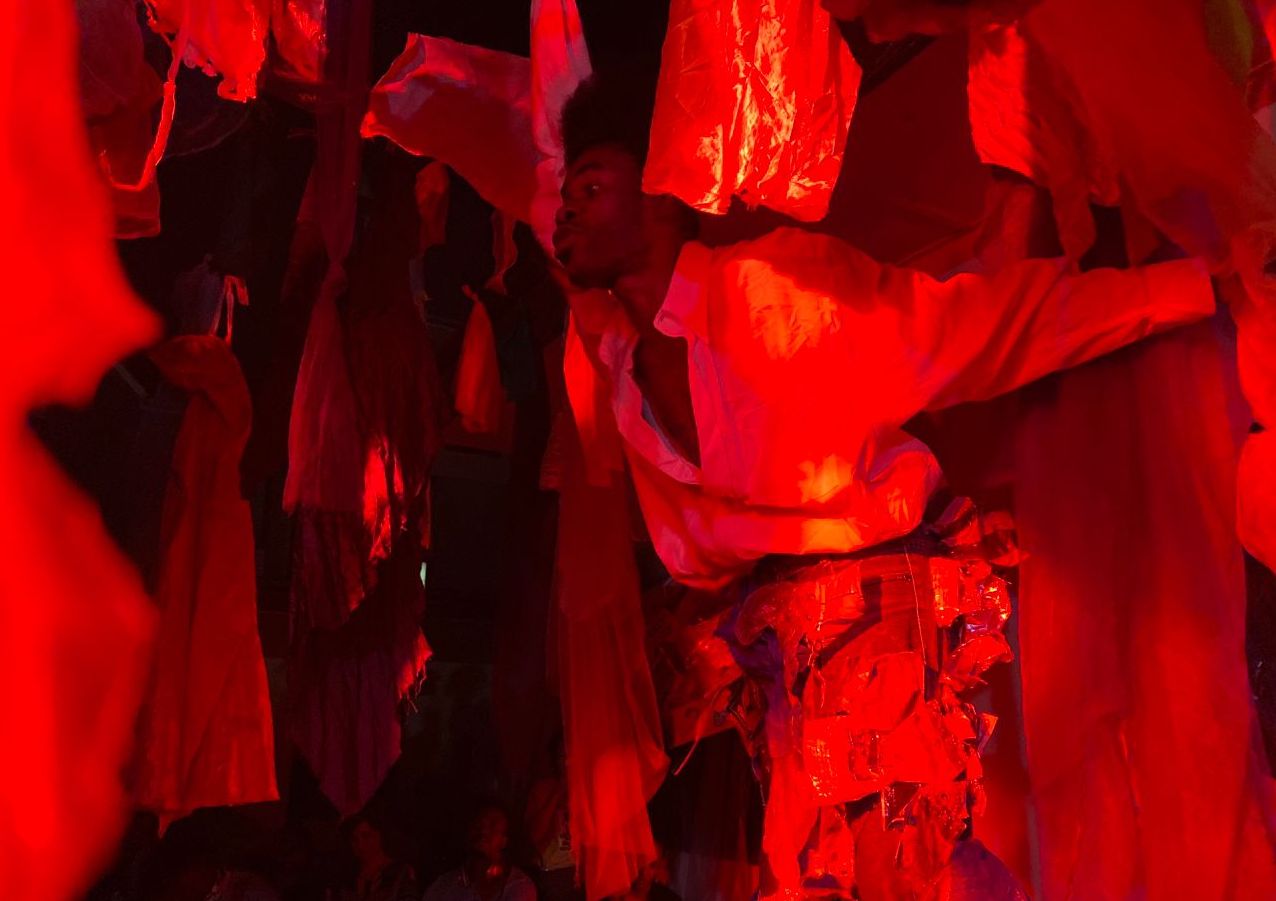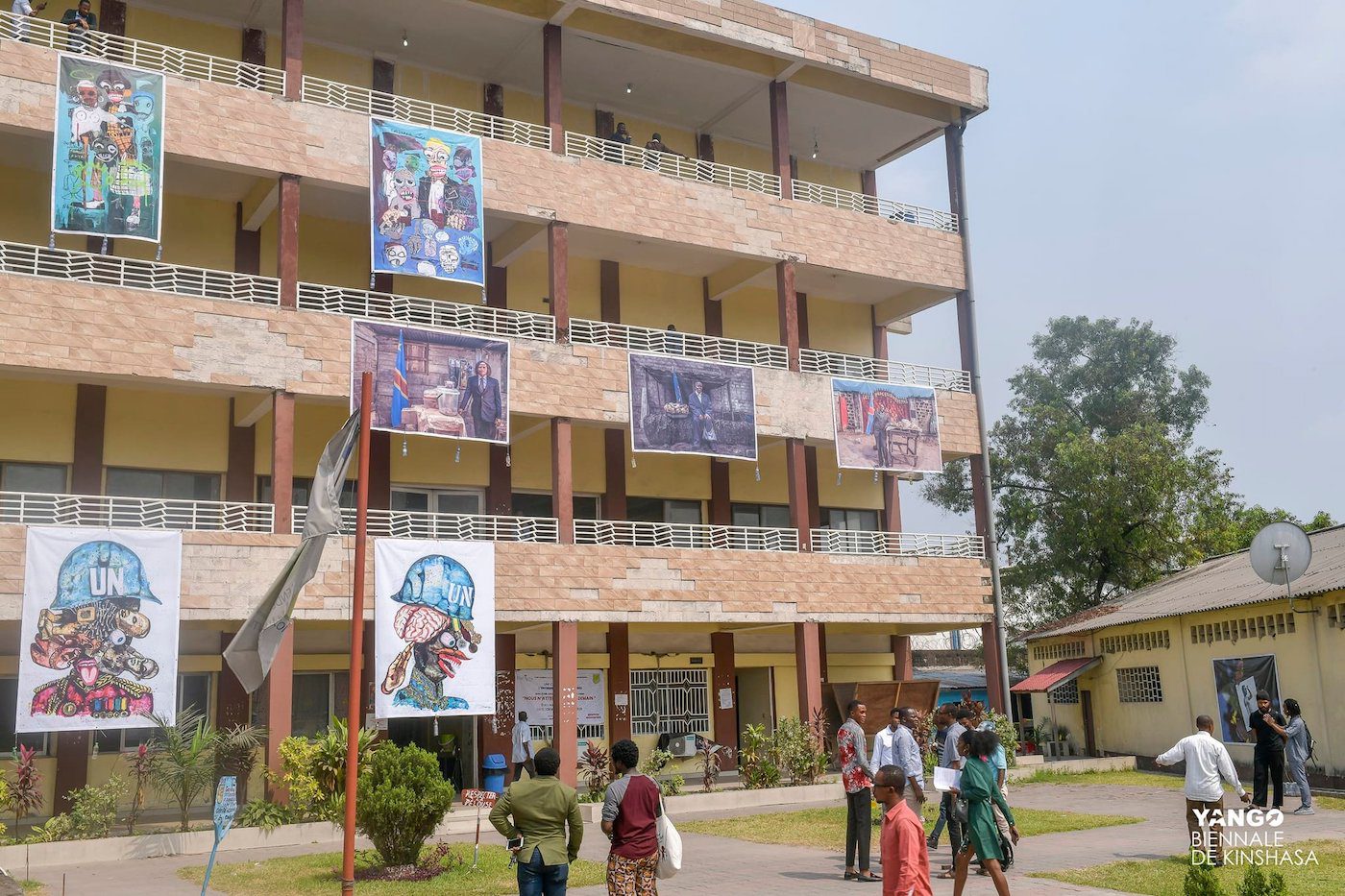C& author Costa Tshinzam has attended the second edition of a long-awaited biennial that has managed to put itself back on the world map of artistic events.

Performance by Azazou Show. Photo: Costa Tshinzam
The 2nd edition of the Yango Biennial in Kinshasa extends across the Democratic Republic of Congo’s capital from July 13 to August 14, 2022. It aims to establish itself as “a processual, shape-shifting Biennial, capable of asserting itself as a social force,” according to the curatorial statement by Nadia Yala Kisukidi and Sara Alonzo Gomez’, curators in charge of the artistic direction of the contemporary art festival. From Kinshasa, it is a questioning of the very relevance of making art in Africa, in a world shaken by all kinds of conflict.
The provincial city of Kinshasa, known and recognized as a hotbed of talented artists, is the main venue for exhibitions, performances, shows and exchanges through the form of workshops and lectures among artists, researchers, theorists and professionals of this Biennale with the festive event set up across 20 selected sites from the 24 communes that make up the former Léopoldville. This festival, founded by photographer Kiripi Katembo Siku, who died unexpectedly in 2015, brings together contemporary artists from the Congo and its diaspora and those from elsewhere like Claudia Tennant (South Africa), Laeila Adjovi (Benin) or Azazou Show (Cameroon).

Installation View of the exhibition at l’Université Libre de Kinshasa. Photo: Yango Biennale de Kinshasa
With more than 20 venues (re)converted into exhibition spaces, the city-province of Kinshasa, the largest city in the Democratic Republic of Congo as well as in Africa and the largest French-speaking metropolitan area in the world since 2010, welcomed more than 30 artists to shine and make “Kinshasa-la-Belle” shine through their creativity. To display art in the city, the organization used billboards and the walls of various public spaces as an exhibition medium. The Biennale’s internet site and social networks also promoted the event, by presenting very short videos by 30 invited artists, and their respective creations, perceptions and conceptions of the world or worlds around them.
The workshop sessions, organized in advance, enabled the artists to seize Kinshasa’s “present” where “maps shift, transform and produce new images and unpublished texts that visual artists, musicians, writers, slammers, videographers and photographers contributed and put together, against the backdrop: “We will not await tomorrow!”
It should nonetheless be noted that this Biennale has gone through difficult times which could explain such a long “reproductive gap” between the organization of the first and second editions of a contemporary art festival which experienced a painful delivery of its offspring. However, despite the sudden death in 2015 of visionary of the event Kiripi Katembo Siku and the crisis linked to the pandemic of the new coronavirus which, when it was declared in China in 2020, shook the world, imposing several postponements on the organization of the current edition, curators Nadia Yala Kisukidi and Sara Alonzo Gomez seem to have taken challenge upon themselves, anxious to put this mass of contemporary art back on the world map of artistic events.
The choice of artists is not trivial. Not only does it enable establishing and maintaining a strong network of exchanges of experiences between known and recognized artists and those whose visibility is beginning to be established, from the north as well as the south from the “Salt Market” ; above all, it responds to the initial objective set by the Biennale’s founder: “To provide a framework of professionalism and connection to the world, anchored in the urban space they (the artists) question in their creations.” Friday, July 15, 2022. 3PM. Kabambare roundabout in Barumbu: The Swiss Aurélien Gamboni, who leads a practice of artistic investigation, conducted, as usual, fieldwork which he then displayed in the form of an artistic collective performance called “COOP. Kin” in collaboration with Congolese Blaise Musaka and Michael Disanka, director of Collectif d’Art-d’Art. One hour later, this time at the Plateforme Contemporaine in Barumbu : the Franco-Beninese photographer Laeila Adjovi who grew up in several African countries and whose artistic approach consists of combining drawing and photography, the woman who with journalist Aurélie Fontaine in 2015 led a project consisting of photographs and testimonies about the wives of migrants who stayed in the country while their husbands left in search of a better life in the West, presented “Vernissage du parcours” (A View of the Journey) in collaboration with Paulvi Ngimbi, Prisca Tankwey, Malafi Niamba and Sammy Baloji. At 6PM, in the same location, Cameroonian actor Azazou Show, in collaboration with Junior Mungongu, presented his performance “ESSINGANG”. It is a show that he created in 2018, which he researched for two months at OTHNI-Theater Lab in Yaoundé.
We’re fed up with waiting for tomorrow!
The desire to establish itself as a “processual, shape-shifting Biennale, capable of asserting itself as a social force,” brings us back to the need to plan, to enter into a dream process which aims for change that is ardently desired by a youth for “tomorrow’s future”; a youth who, because of these artists from Kinshasa, are aware of the fact that “tomorrow is already today” and that making art is already taking a position, facing the challenges to be met. It’s not about a harried youth getting lost by going in all directions trying to find themselves. It’s an orderly youth, who are tired of maintaining the status quo; a youth determined to carry uncompromisingly the dream of a better future starting “today”, like Kwame Nkrumah and Patrice Emery Lumumba wanted, when the cries for independence rang throughout Africa. This is even more necessary in this contemporary world, which tends to trivialize dreams, “relegating them to the peripheries of the sociocultural ontological edifice” even as “dreaming serves to mediate the consolidation of the memory and mood relationship” so destroyed by years of unemployment, the high cost of living, wars, looting, rape and theft that plague the country, with the complicit silence of an international community of “businessmen”! “We Will Not Await Tomorrow” therefore resonates as a call for self-determination, for a youth enamored with change, who have not forgotten what Lumumba wrote in his last letter: “… I want people to say that the future of the Congo is bright and it expects them, as it expects each Congolese, to accomplish the sacred task of rebuilding our independence and our sovereignty, because without dignity, there is no freedom, without justice, there is no dignity, and without independence, there are no free men.” The curators of this event put it in the most beautiful way: “These imaginings are diurnal: they require our perspicacity, rather than making promises. They reconfigure a tangible, concrete utopia, conjugated in the present tense.”
After a first edition of the Yango Biennale in Kinshasa with the theme “Moving Forward”, directed by Sithabile Mlotshwa who tried to open the event in only six sites in the city, including the Academy of Fine Arts, the French Institute of Kinshasa, the Wallonie-Bruxelles Center and the Central Station Square while associating artists from the Congo and its diaspora with others from African countries, from Belgium and even from China, like Freddy Tsimba, Chéri Samba, Ousmane Mbaye, Mega Mingedi, David Kazadi, Francis Mampuya and Kura Shomali, by claiming “Kinshasa as a hub of the planetary art scene”, the curators selected for the artistic direction of this edition is justified, because it allows for an appropriation, a local anchoring by placing Kinshasa in the spotlight of the whole world. But it could also be a trap in the face of outside expectations: of artists, curators, or quite simply, those who give popularity to artists and their creations, which are not always easy to satisfy through a format such as this. We may also be tempted to open the debate on the impact of a Biennale like this one, which is held in the same city and almost on the same dates as the Congo Biennale, another event which could use artists and audiences from the same ecosystem. It seems obvious that this is not enough to meet all the artistic needs of Kinshasa, a city of more than 17 million inhabitants (2021 figures), recognized as a hotbed of talented artists.
The idea of creating a framework of professionalization, connection to the world and an anchoring in the urban space that artists question through their creations would imply that even the existence in the city of an Academy of Fine Arts would not be enough to imagine, create and consolidate a strong network of exchanges of experiences, with a view to allowing artists from Kinshasa to shine for themselves as well as for the city and the country, by asserting itself as a social force. That is why this second edition of the Yango Biennale in Kinshasa seems to succeed in its role of putting this Biennale (back) on the world map of artistic events. It also makes art a driving force for development for a people who are fed up with waiting for tomorrow!
Costa Tshinzam is a writer, blogger, and author who is a member of the Habari RDC community. He is a mentor for the C& critical writing workshop in Lubumbashi, where he lives and works.
Translation by Sara Hanaburgh.
More Editorial